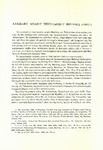Ανασκαφή αρχαίου νεκροταφείου Βεργίνης (1960/61)(Πίν. 92-153)

Προβολή/
Συγγραφέας
Πέτσας, Φώτιος Μ.Ημερομηνία
1963Γλώσσα
el
Εκδότης
Υπηρεσία Αρχαιοτήτων και Αναστηλώσεως
Λέξη-κλειδί
Βιβλιογραφικά στοιχεία
Αρχαιολογικόν Δελτίον, 1961/62, Τόμος 17, Μελέται/Μέρος Α’, 218-288.
Πρόσβαση
ελεύθερη
Τίτλος περιοδικού
Αρχαιολογικόν Δελτίον
Επιτομή
A new motorroad from the Haliakmon dam to Meliki which crossed the ancient
cemetery of Vergina necessitated rescue excavation on a wide scale. The new road cuts
the cemetery from east to west for a distance of about 500 m. The width of the road
is 12 m. but it was decided to explore an area 24 m. in width. Moreover where this
area included part of a tumulus, the tumulus was explored completely and in such
places the width of the excavated area extended to about 30 m. Within this area,
500 m. long and about 30 m. wide, about 70 tumuli, numbered with Roman numerals
(I - LXXIII) were recorded and excavated. The 21 tumuli at the east end were
completely excavated in 1960; the excavation of the rest was completed in 1961.
The top of each tumulus is shown on the plans by two concentric circles. Whereever
the enclosing circle of stones was preserved either completely or partially it also is indicated. Each tumulus was excavated completely to ground level, an area which
generally coincided with the extent of the enclosing wall. Cuttings to a greater depth
are also shown on the plans.
The burials in each tumulus are distinguished by the letters of the Greek alphabet
and the finds by arabic numerals. Thus, for example, object LXV B 10 means
find 10 from tumulus LXV and from the burial lettered B in that tumulus. This
system of numbering differs from that used in the systematic excavation of the
cemetery by Mr. M. Andronikos. It was adopted on the assumption that the letters
of the Greek alphabet would be sufficient to distinguish the burials in each tumulus.
However for tumulus LXV which produced 59 burials it was necessary to use the
alphabet a second time with the prefix A (AA to ΑΩ) and the first eleven letters of
a third series with the prefix B (BA to BA).
The first 65 tumuli are described in the present report. Of these tumuli I, III, L,
LV, LVIII, LXIV and LXV were either completely or partially prehistoric belonging
to the Early Iron Age. In these, particularly in tumuli III and LXV, were found
interments in pithoi or within stone enclosures but there were also cremation burials,
particularly in tumuli L, LV and LVIII. Tumulus LXIV contained both inhumation
and cremation burials. In the prehistoric tumuli the burials were made at approximately
the level of the surrounding surface. Perhaps the most interesting find from
the prehistoric tumuli is a pithos used as a cinerary urn (LXV ΑΞ 221). It is decorated
with Protogeometric concentric circles painted with a multiple brush and with
bands painted freehand. It had cracked in two in the firing which seems to indicate
that it is of local manufacture, as I have shown in the full publication to appear in the
memorial to Karl Lehmann.
The majority of the remaining tumuli belong to the early Hellenistic period.
Coins of Kassander were found with some burials. The Hellenistic burials are found
at a depth of 1-2 m. below the level of the surrounding surface.
Two other prehistoric tumuli of the same cemetery were damaged by the construction
of an irrigation canal and it was necessary to explore them in 1960 (tumuli
C and Cl). They both belong to the Early Iron Age, but contained as well later burials
from the last years of the Turkish occupation. The most notable of the prehistoric
burials was CA in which among other objects was found a bronze sword 0.72 m. in
length. This is perhaps the most important find from the whole Vergina Cemetery.
The sword is of northern type and can be dated to the end of the Bronze Age or the
beginning of the Early Iron Age. Burial CA is typical of the later burials in these
two tumuli. The body in it was found without a head and there was a lead bullet
lodged between the ribs.
The other tumuli from the area of the road (LXVI-LXXIII) will be described in
a further article when the cleaning and mending of the finds has been completed.


